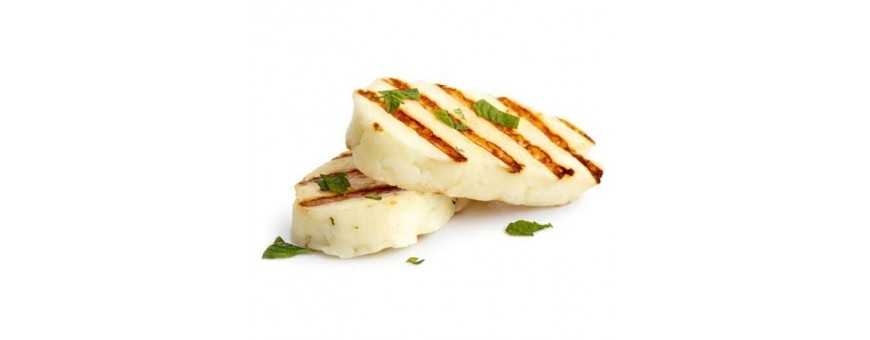Sorry for the inconvenience.
Search again what you are looking for
SOXLANA offers you everything you need. Be satisfied first and then pay later.

Halloumi is a cheese originating from the island of Cyprus. Its white, fresh paste, sprinkled with chopped mint leaves, has a unique texture. It is slightly pressed, but remains supple and elastic. Halloumi can be eaten fresh, grilled or fried.Originally from the island of Cyprus, Halloumi is made from a mixture of goat, sheep and cow's milk. It was born from the need to store milk and have proteins during the winter period. Today halloumi is one of the main foods of the Cypriot diet. Cook it on the barbecue, it does not melt during cooking, it's a delight!
This cheese, originating in Cyprus, is traditionally made from sheep's or goat's milk, but it is also found with cow's milk.
Very appreciated in Turkish cuisine, it is often used in salads, but also on kebabs.
You can enjoy it plain, but it will be best grilled on the barbecue or fried in olive oil.
Halloumi is also known for its ability to retain its shape and not melt when cooked.
Halloumi cheese foundations
Traditionally made from sheep's milk on the Greek island of Cyprus, Halloumi is a soft, rennet-free cheese. It is safe for vegetarians who do not eat rennet.
Many similar types of cheese are made by dairy and goat producers in Canada and the United States. For reasons of legal ownership, these cheeses are generally referred to as halloumi cheeses. Sometimes they are called grilling cheese or frying cheese, or queso de simmering in Spanish. You may find them similar to Greek Hallois, but some people prefer the original.
Substitution of another cheese for Halloumi
Depending on your recipe, halloumi is usually not easy to replace. Tofu or Indian paneer can be used in some recipes, but it won't be quite the same as halloumi or a similar cheese to grill.
What does Halloumi cheese taste like?
Halloumi is served natural and firm, salty and a bit chewy. It is perhaps more comparable to a thick tasting feta with a smoother texture, although the halloumi taste is certainly unique.
But halloumi is not meant to be eaten naturally. It must be reheated, grilled or put in cooking so that you can fully enjoy it. When cooked, the salty taste turns into a savory bite, with a slightly creamy texture. Grilled or fried, it's really delicious.
Think of Halloumi as the marshmallow of cheeses: an eaten plain is nothing special and even tastes a little weird, but nicely crunchy over an open flame (or grill), halloumi and marshmallows become beautifully crispy and flavorful on the outside, sensually melted on the inside and cannot really be compared to any other food experience or taste. You really have to try it.
How to cook Halloumi cheese
Try the grilled, pan-fried or thinly sliced halloumi. Use it in place of mozzarella in a Caprese salad or serve it with watermelon, as it is traditional in Cyprus.
Nutritional information for Halloumi cheese
1 piece of halloumi cheese contains:
90 calories 8 grams of total fat (12% of daily intake)
20 mg of cholesterol (12% of daily intake)
300 mg sodium (12% of daily intake) 0 grams of carbohydrate
0 grams of dietary fiber
0 grams of sugars
6 grams of protein
20% of the RDA for calcium
0% of the RDA for vitamin C, vitamin A and iron
Halloumi cheese recipes
If you're ready to try halloumi cheese, you can grill it in a grill pan, or even just fry it in a pan with a little oil. It is easy to experiment with grilled Halloumi cheese or traditional 3 minute fried Halloumi meze cheese. You can not be wrong!
Testimonial:
Halloumi, the Cypriot cheese that comes to our plates
“It’s really a staple ingredient in our cooking. Our Gruyère cheese on the island is halloumi, ”begins Constantinos Talianos, economic and commercial adviser at the Cyprus embassy in Paris. Although it is very present in Greek cuisine, halloumi is a typical Cypriot cheese. Its flavor, it owes to traditional preservation methods that producers are keen to preserve.
The product, a mixture of sheep's and goat's milk (with a touch of mint), like its distant cousin the feta, is kept in large jars of salt. In the fridge, it can be kept for up to a year as long as it is not started. Imported for twenty years by discerning connoisseurs, halloumi is still struggling to establish itself in French supermarkets, despite growing demand. According to Constantinos Talianos, "it is not referenced consistently, unlike the UK, for example".
The authentic halloumi
Good to know
Inhale the [h] when you say "halloumi", and emphasize the sound [l]. Your pronunciation will be perfect.
How do we eat it?
Its semi-hard paste has the particularity of not melting in heat, which offers a multitude of possibilities to consume it. "Its taste is quite neutral, it does not have the strong flavor that you associate with sheep's or goat's milk. Halloumi is a little salty but it becomes less when it is cooked, ”explains Mathieu Crescence, employee at Kilikio, a Greek delicatessen in Paris (1).
The advantage of halloumi? It can be eaten in all forms. Cold or hot, raw, cooked or simply grilled. In Cyprus, one will not escape its association with fresh watermelon. Gourmets will just grill it with a drizzle of thyme honey to give it a caramelized taste.
Mathieu Crescence suggests tasting the halloumi "in breadcrumbs with a little oregano, olive oil and lemon". It can be enjoyed at any time of the meal, both as an aperitif and for dessert, where it is diced in a salad of fresh fruit. It's up to you to test and find the combination that you like.
Search again what you are looking for
This website uses cookies. By continuing to browse the site, you accept our use of cookies. En savoir plus ici.
